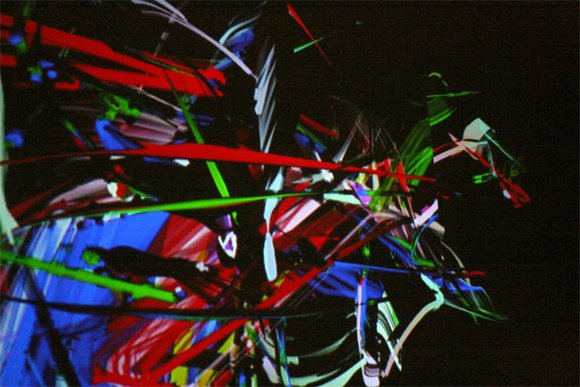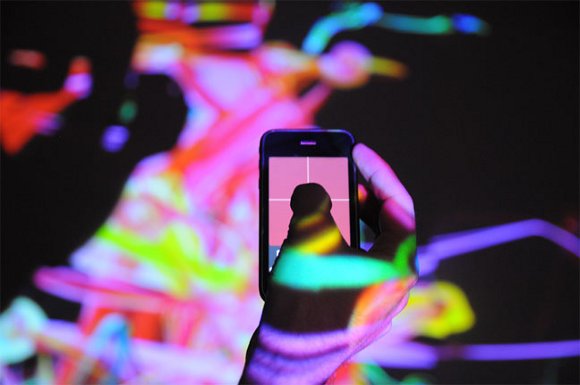
Automatic for the people: the beauty of mrmr is that it’s an instantaneous, ubiquitous interface for any interactive visuals. Walk up to an installation, and via wifi, your mobile device receives a set of controls that can be used to manipulate what you see. You can collaborate on performances, provide interactions with software and data – really, anything you might like. The mrmr client, currently available for iPod touch and iPhone (with iPad support awaiting iTunes approval), is a protocol built atop network standards OSC and Zeroconf (Apple’s Bonjour). That means it and tools like it should soon come to other devices, including browsers and Android.
This week in New York, I’m part of a gallery show + workshop that shows off what mrmr can do – but more broadly, what networked touch devices can do, thanks to network standards. We’ll have several interactive visual pieces, like the gorgeous Superdraw/Multidraw by Joshue Ott pictured here. Then, after Friday night’s opening, on Saturday we’ll teach you how to make use of these technologies in your own work. (For those of you who can’t get to NYC – that being about 98% of you – I hope to share more online this week. And I hope to get more discussion, code, patches, and lessons online this year, especially as I work on new clients for browsers and Android and not just iPlatforms.)

The opening is Friday, April 9 at 7pm, at Devoted Gallery, Brooklyn.
By the way, for more workshop-y goodness, check out the Arduino, Max, and Pd events in LA this week and in May.
Full details below.
Multi-User Art reimagines the gallery for the age of the iPhone, with a set of installations that invite multiplayer action from showgoers’ own mobile devices. The show features artists at the forefront of establishing open standards by which mobile gadgets can interact creatively. Joshue Ott’s work translates user touch into meditational, abstract, three-dimensional drawings. Eric Redlinger places viewers as astronauts in a shimmering lunar landscape from the Apollo mission.
Peter Kirn creates a playful, interactive toy theater that challenges users with quirky, game-like interactions. Chris Jordan uses mechanically-controlled mirrors manipulated by the viewer to transform reflected light into a poetic examination of the relationship of the US with China. By harnessing the ability to use touch to tweak on-screen faders and push virtual buttons, Devotion Gallery becomes a space in which visitors can play with, and perform the art they see.If you’re ready to learn how to make use of these emerging technologies, a beginner and advanced workshop will give you the skills you need to make your own art, music, visuals, and digital communications using your own computers and mobile devices, with free and open tools.
ARTISTS:
Eric Redlinger, Small Steps (computer,projector)Small Steps lets the viewer assume the role of an Apollo astronaut, exploring a shimmering, 3-dimensional lunar landscape by tilting and rotating their iPod. There are even controls to ‘space jump’ to get an eagle-eye perspective, and camera filters to better discern the terrain by applying color highlights to crevices and craters. Small Steps generates its environment not through traditional 3D modeling methods, but rather by presenting actual, ultra-high-resolution NASA
lunar imagery from the Apollo 16 mission, and then applying technology that extrudes shaded areas using an analog video technology developed by Bill Etra and Steve Rutt in 1972, the same year as the Apollo.Joshue Ott, Superdraw/Multidraw:Guided1 (computer,projector,speakers)
multiDraw:guided1 (working title) promotes collaboration and
interaction with a unique system of multi-sensory stimulation,
involving visual and audible elements. It allows the participant to create their own space within the space of the piece, crossing the boundary from being a passive audience member into the realm of creating the art itself, while remaining within the framework of the project.superDraw was originally conceived as a visual alternative to a
musical instrument, and has developed into a live generative art system, which uses a computer to augment the simple act of drawing – transforming it into an evolving process whereby the user can watch their input shift in a careful balance of control and chance. multiDraw is the multi-user version of the instrument, and creates an immersive experience for multiple people to engage with and share, in a marriage of technology and interactive art.Peter Kirn, The Enigmatic Box (projector, computer, speakers, custom electronics)
Using an embedded computer system, The Enigmatic Box pokes fun at interaction by responding to user input in unexpected ways. On a display and in semaphore-like patterns of LEDs, the installation is an anti-game, responding in foreign languages and sounds as if a fragmented human memory is trapped in the computer. As the remnants of tangible, conventional interfaces sit inside shadow boxes like captured endangered species of the Amazon, the installation responds
to and resists mobile input in novel sound and image. It’s a “Busy Box” for adults.Chris Jordan, Qu Yuan Goes West (mirror, motors, computer, projector)
“Qu Yuan Goes West” is an interactive light installation allowing for up to four people to control light and pattern using the iphone/touch interface. The installation utilizes computer, projector, mirrors, and motors. “Qu Yuan Goes West” examines the US/Chinese relationship; and how individual identity and capital (yuan) are transferred between nations. The title refers to the first ‘named’ Chinese poet Qu Yuan, as well as chinese currency (yuan).
WORKSHOPS:
Saturday April 10 | 11am-12pm | Getting your Face out from Behind the Screen: Creating a Remote-Control Interface for Your Interactive Project by Eric Redlinger | Free |The tyranny of the computer monitor is something that interactive media performers have long struggled with; while dancers, musicians and other performance artists are free to interact with the audience while performing, computer artists are generally stuck behind their screens. With the recent explosion of consumer touch-screen devices, however, many of us now have the tools we need to get out from behind the screen already in our pockets. This demonstration highlights one solution for using your iPod/iPhone to control your performance or installation by leveraging the free Mrmr platform, presented by a lead developer of the project. You’ll see an overview of all the steps in the process, including designing and creating your mobile interface, installing the interface on your mobile device, and connecting it all to your existing project. This demonstration also serves as an
introduction to the more in-depth and hands-on workshop “Smart Art: Making Digital Media Connect”.Saturday April 10 | 1-4pm | Smart Art: Making Digital Media Connect by Joshue Ott and Peter Kirn | $75.00 |
sign up here: http://www.areyoudevoted.com/classes/smart-art-making-digital-media-connect-by-joshue-ott-and-pet.html
Working with free tools, with an emphasis on Processing and Pure Data (the free cousin of Max/MSP), see how OSC can make control messages human-readable, intelligent, interactive, and precise. Connect software in different media, devices from computers to smartphones, and users in the same room or across the globe. Learn how network standards can make connecting easy – no system administrators required. And see how open, free development makes collaboration easier. Whether you want to collaborate with another artist or simply
make music and visual software talk to one another for a performance, we’ll give you the basic tools to get started.PREREQUISITES: For both workshops, some basic experience with a tool such as Processing, Max, OpenFrameworks, or Pd is recommended, but no previous experience with Open Sound Control (OSC) is needed.
Gallery info and directions:
http://www.areyoudevoted.com